Making Sense of Food Labels in Japan
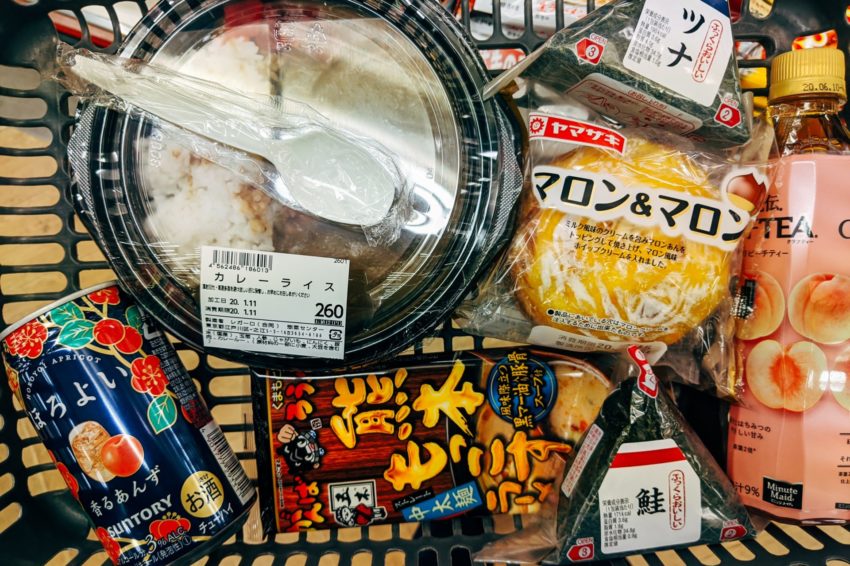
Top Photo by Markus Winkler on Unsplash
Undoubtedly, one of the most daunting tasks facing newcomers to Japan is trying to glean useful information from the labels on food products. We all have to eat, and many of us want or need to know information about foods before we buy them, so understanding the content on these labels is essential for many people. In the case of the Japanese language, even learning to read simple kanji can be quite a test of one’s skills, so deciphering the content on a food label can seem like a nearly impossible task. This guide should help you make sense of the food labels you encounter.
Example Labels
The following photos (all of the same product) show the different types of information you may find on food packaging. They can be divided into four separate labels: the product information label (including a list of ingredients), the nutrition label, the allergy warning label, and the best by date label.
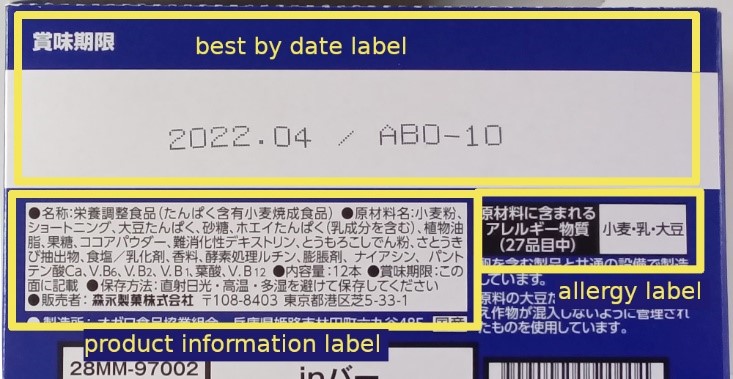
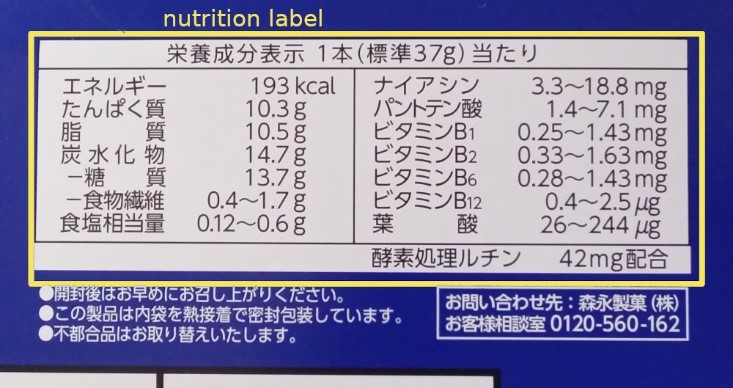
The Allergy Warning Label
If you are one of those unfortunate enough to have food allergies, of course the absolute most important thing to check when buying food is a description of the allergens it may contain. Fortunately, many food products produced in Japan have prominent allergy warnings placed on them, which are fairly easy to spot.
Here is an example allergy warning label:
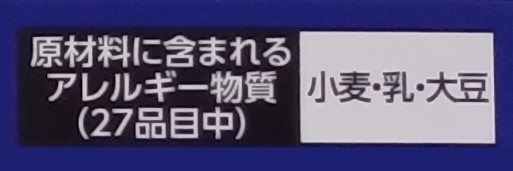
Note that the allergy warning label is usually separate from the two main labels (product information label and nutrition label) on the product. Also note the white text on black background in the photo above. While not all products use this color scheme, many do, or at least use bold text to help make this information stand out. The right side of this label indicates the allergens the product contains – in this case wheat, milk, and soybeans.
There is an established set of 27 different items that may appear on Japanese allergy warning labels, as listed below. The first seven of these are required to be listed, while the others are optional.
| food item | translation |
| えび | shrimp (prawns) |
| かに | crab |
| 小麦 (こむぎ) | wheat |
| そば | buckwheat |
| 卵(たまご) | eggs |
| 乳 | milk |
| 落花生(らっかせい) | peanuts |
| あわび | abalone |
| いか | squid (cuttlefish) |
| いくら | salmon roe |
| オレンジ | oranges |
| カシューナッツ | cashews |
| キウイフルーツ | kiwifruit |
| 牛肉 | beef |
| くるみ | walnuts |
| ご ま | sesame |
| さけ | salmon |
| さば | mackerel |
| 大豆 | soybeans |
| 鶏肉 | chicken |
| バナナ | banana |
| 豚肉 | pork |
| まつたけ | matsutake mushrooms |
| もも | peaches |
| やまいも | Japanese yams |
| りんご | apple |
| ゼラチン | gelatin |
Although some of these terms may be written differently on some food packaging than in the above list (for example, using hiragana, katakana, or kanji), the way the terms are written above is most common. Because the first seven of these are so important, additional ways of writing some of them have been provided above, in parentheses.
The Best By Date
In Japan, there are two different types of best by dates: one which indicates by what date you can expect the food to still taste good, and one which indicates the date after which the product should no longer be consumed. Most products will only have one of these two dates. Here are the useful terms you may see on this label.
| term | meaning |
| 賞味期限 | best taste by |
| 消費期限 | use by (i.e., do not use after) |
| (未開封) | unopened package (i.e., the best by date is applicable only to unopened packages) |
The best by date is usually stamped in a conspicuous place on the product. If you are unable to find it, the product information label will have an entry on it telling you where to look on the product to find the date. When there is both inner and outer packaging, the date may only be stamped on one of these.
The Product Information Label
The product information label contains various types of information about the product, including its name, the company which produces it, and a list of ingredients. Useful headings you will find on the product information label include:
| heading | meaning |
| 名称 | product name |
| 原材料名 | ingredients names (i.e., ingredients list) |
| 保存方法 | product storage recommendation |
The Nutrition Label
The nutrition label is similar to nutrition labels found today in almost any country. This label includes such standard information as caloric value, the amount of protein, fat, and carbohydrates, the salt content, and also the amounts of various types of vitamins and minerals. Useful terms you will encounter include:
| term | meaning |
| 栄養成分表示 | nutritional composition label (i.e., the name of this label) |
| エネルギー | caloric content (usually expressed in kilocalories) |
| たんぱく質 | protein |
| 脂質 | fat content |
| 炭水化物 | carbohydrates |
| ―糖質 | — sugar |
| ―植物繊維 | — fiber |
| 食塩相当量 | salt equivalent |
Near or at the top of this label is the relevant serving size. Here are some example serving sizes you may see:
| serving size | translation |
| 1食分(180g)当たり | one serving (180 grams) |
| 1缶当たり | one can |
| 1本(37g)当たり | one bar (37 grams) |
Note that the term 当たり(あたり) appears in all serving sizes, and basically means “applicable to”.
Genetically Modified Foods Notice
Some people today are concerned about the use of GMOs (Genetically Modified Organisms) in their foods. For that reason, many labels are starting to include statements about use of GMOs. If this is a concern for you, the key phrase you need to look for on the packaging is:
| term | meaning |
| 遺伝子組み換え /
遺伝子組換え |
genetically modified |
Here is one such notice found on actual food packaging:

This particular notice explains that the corn used in this product is not genetically modified.
One Final Trick
Hopefully, most people coming to live in Japan already know about the following trick, as it is incredibly beneficial, not to mention amazing. On your smartphone, you can use an app such as Google Translate to perform a live translation of a food label. In the case of Google Translate, first launch the app and be sure to specify Japanese to English translation. Then select ‘camera’, and make sure that ‘Instant’ is selected. Hover the camera over the text you want to have translated, keeping it as steady as possible. The text will automatically be translated. The translated text will appear in place of the original text.
Here is what the above allergen label looks like in its original form, and when automatically processed by Google Translate:
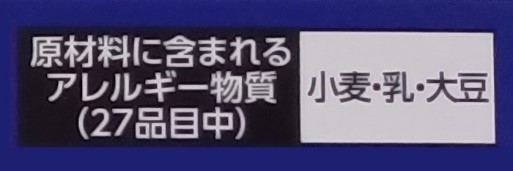

You can see that the original text is overwritten with translated text. And this translation is performed automatically through your phone’s camera! Very convenient!
Please be advised that sometimes the translation can change depending on the angle you’re holding your phone. Keep your phone steady and parallel to the product surface for the best result.
Final Message
Hopefully, all of the advice and terminology provided in this article should give you a big boost in interpreting food labels in Japan. Happy (and healthy) eating!
Photo Credits:
Top Photo by Markus Winkler on Unsplash
Additional photos provided by the original author (self-taken & edited)
All other content (text) created by the original author and © 2021 MUSUBI by Borderlink
RELATED
-
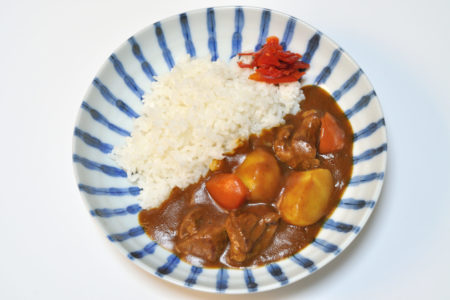
Delicious Curry on the Cheap
Top Photo: Ocdp used under the Creative Commons CC0 1.0 Universal Public Domain Dedication. Wikimedia Commons … -

Our Top 3 Tonkotsu Ramen Spots
Top Image: Quang Anh Ha Nguyen on Pexels When you think of Japanese food, chances are you think of two things:… -
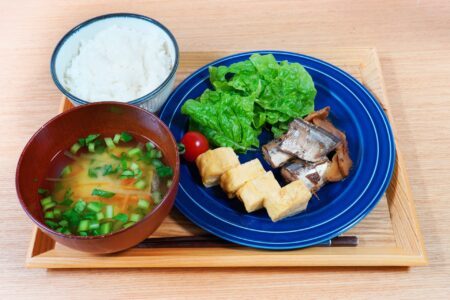
My Ten Yen on Healthy Eating in Japan
Top photo: ojisan200 on PhotoAC Eating healthy in Japan can make you feel good and bring you joy. Japanese foo…
PEOPLE

The MUSUBI Staff
Collaborative works put together by our many talented writers and editors!


